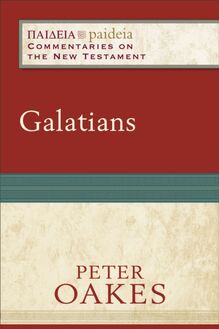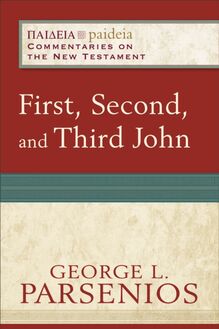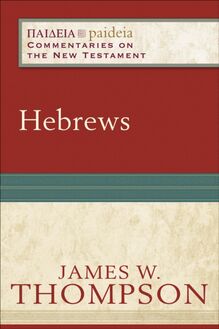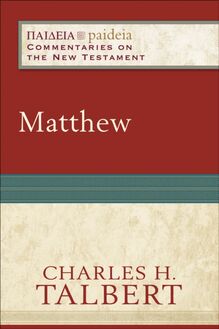-
 Univers
Univers
-
 Ebooks
Ebooks
-
 Livres audio
Livres audio
-
 Presse
Presse
-
 Podcasts
Podcasts
-
 BD
BD
-
 Documents
Documents
-
- Cours
- Révisions
- Ressources pédagogiques
- Sciences de l’éducation
- Manuels scolaires
- Langues
- Travaux de classe
- Annales de BEP
- Etudes supérieures
- Maternelle et primaire
- Fiches de lecture
- Orientation scolaire
- Méthodologie
- Corrigés de devoir
- Annales d’examens et concours
- Annales du bac
- Annales du brevet
- Rapports de stage
La lecture à portée de main
Vous pourrez modifier la taille du texte de cet ouvrage
Découvre YouScribe en t'inscrivant gratuitement
Je m'inscrisFirst and Second Thessalonians (Paideia: Commentaries on the New Testament) , livre ebook
Découvre YouScribe en t'inscrivant gratuitement
Je m'inscrisEn savoir plus
Vous pourrez modifier la taille du texte de cet ouvrage
En savoir plus

Description
Informations
| Publié par | Baker Publishing Group |
| Date de parution | 16 novembre 2021 |
| Nombre de lectures | 0 |
| EAN13 | 9781493432158 |
| Langue | English |
| Poids de l'ouvrage | 26 Mo |
Informations légales : prix de location à la page 0,0720€. Cette information est donnée uniquement à titre indicatif conformément à la législation en vigueur.
Extrait
Half Title Page
Series Page
G ENERAL E DITORS
Mikeal C. Parsons, Charles H. Talbert, and Bruce W. Longenecker
A DVISORY B OARD
†Paul J. Achtemeier
Loveday Alexander
C. Clifton Black
Susan R. Garrett
Francis J. Moloney
Title Page
Copyright Page
© 2021 by Timothy A. Brookins
Published by Baker Academic
a division of Baker Publishing Group
PO Box 6287, Grand Rapids, MI 49516-6287
www.bakeracademic.com
Ebook edition created 2021
All rights reserved. No part of this publication may be reproduced, stored in a retrieval system, or transmitted in any form or by any means—for example, electronic, photocopy, recording—without the prior written permission of the publisher. The only exception is brief quotations in printed reviews.
Library of Congress Cataloging-in-Publication Data is on file at the Library of Congress, Washington, DC.
ISBN 978-1-4934-3215-8
Unless otherwise indicated, all Scripture quotations are the author’s translation.
Scripture quotations labeled NRSV are from the New Revised Standard Version of the Bible, copyright © 1989 National Council of the Churches of Christ in the United States of America. Used by permission. All rights reserved.
Baker Publishing Group publications use paper produced from sustainable forestry practices and post-consumer waste whenever possible.
Dedication
To my beloved children Adam, Ryan, and Caitlin
Contents
Cover
Half Title Page i
Series Page ii
Title Page iii
Copyright Page iv
Dedication v
List of Figures and Tables viii
Foreword ix
Preface xi
Abbreviations xiii
1 Thessalonians 1
Introduction to 1 Thessalonians 3
1 Thessalonians 1:1–10: Letter Opening 27
1 Thessalonians 2:1–12: Paul’s Ministry in Thessalonica 40
1 Thessalonians 2:13–16: Renewed Thanksgiving 52
1 Thessalonians 2:17–3:13: Paul’s Desire to Visit Again 64
1 Thessalonians 4:1–12: Exhortation, Part 1 80
1 Thessalonians 4:13–5:11: Exhortation, Part 2 94
1 Thessalonians 5:12–22: Final Exhortations 115
1 Thessalonians 5:23–28: Letter Closing 128
2 Thessalonians 135
Introduction to 2 Thessalonians 137
2 Thessalonians 1:1–12: Letter Opening 154
2 Thessalonians 2:1–3:5: Letter Body 168
2 Thessalonians 3:6–15: Final Exhortation: Admonition against Irresponsible Living 190
2 Thessalonians 3:16–18: Letter Closing 201
Bibliography 205
Index of Subjects 215
Index of Modern Authors 219
Index of Scripture and Ancient Sources 221
Back Cover 234
Figures and Tables
Figures Fragment from the Earliest Copy of 1 Thessalonians ( 𝔓 46 ) 4 Paul’s Macedonian Ministry 10 Thessalonica and Mediterranean Travel 15 A Votive to the God Osiris 16 News of the Thessalonians following the Founding Visit 18 Travel Routes before and after the Founding Visit 70 Roman Coin Featuring Julius Caesar and Octavian 95 Roman Coin Featuring Emperor Claudius and Roman “Peace” 106
Tables The Parallel Relations in 1 Thess. 4:11–12 93 The First-Person Plural and Exhortation in 1 Thess. 5:8–10 111 The Structural Symmetry of 1 Thess. 5:12–15 116 Paul’s Appeals in 1 Thess. 5:12–13 and 1 Cor. 16:15–18 118 The Parallel Structure of 1 Thess. 5:12–13; 5:14; and 5:16–18 123 Synopsis of Structural Parallels between 1 and 2 Thessalonians 142 Other Verbal Similarities between 1 and 2 Thessalonians 143 The Thanksgiving Sections in 1 and 2 Thessalonians 155 The Antitheses between Believers and Nonbelievers 163 The Lord Jesus and the Man of Lawlessness Compared 177 Contrast between Paul and the Ataktoi 193 2 Thess. 3:14–15 and 1 Cor. 5:1–11 Compared 199
Foreword
Paideia: Commentaries on the New Testament is a series that sets out to comment on the final form of the New Testament text in a way that pays due attention both to the cultural, literary, and theological settings in which the text took form and to the interests of the contemporary readers to whom the commentaries are addressed. This series is aimed squarely at students—including MA students in religious and theological studies programs, seminarians, and upper-division undergraduates—who have theological interests in the biblical text. Thus, the didactic aim of the series is to enable students to understand each book of the New Testament as a literary whole rooted in a particular ancient setting and related to its context within the New Testament.
The name “Paideia” (Greek for “education”) reflects (1) the instructional aim of the series—giving contemporary students a basic grounding in academic New Testament studies by guiding their engagement with New Testament texts; (2) the fact that the New Testament texts as literary unities are shaped by the educational categories and ideas (rhetorical, narratological, etc.) of their ancient writers and readers; and (3) the pedagogical aims of the texts themselves—their central aim being not simply to impart information but to form the theological convictions and moral habits of their readers.
Each commentary deals with the text in terms of larger rhetorical units; these are not verse-by-verse commentaries. This series thus stands within the stream of recent commentaries that attend to the final form of the text. Such reader-centered literary approaches are inherently more accessible to liberal arts students without extensive linguistic and historical-critical preparation than older exegetical approaches, but within the reader-centered world the sanest practitioners have paid careful attention to the extratext of the original readers, including not only these readers’ knowledge of the geography, history, and other contextual elements reflected in the text but also their ability to respond correctly to the literary and rhetorical conventions used in the text. Paideia commentaries pay deliberate attention to this extratextual repertoire in order to highlight the ways in which the text is designed to persuade and move its readers. Each rhetorical unit is explored from three angles: (1) introductory matters; (2) tracing the train of thought or narrative or rhetorical flow of the argument; and (3) theological issues raised by the text that are of interest to the contemporary Christian. Thus, the primary focus remains on the text and not its historical context or its interpretation in the secondary literature.
Our authors represent a variety of confessional points of view: Protestant, Catholic, and Orthodox. What they share, beyond being New Testament scholars of national and international repute, is a commitment to reading the biblical text as theological documents within their ancient contexts. Working within the broad parameters described here, each author brings his or her own considerable exegetical talents and deep theological commitments to the task of laying bare the interpretation of Scripture for the faith and practice of God’s people everywhere.
Mikeal C. Parsons Charles H. Talbert Bruce W. Longenecker
Preface
The letters of 1 and 2 Thessalonians are truly underappreciated. In any case, that is the opinion I have come to the more I have studied them. These letters are perhaps best known for their attention to the “end times”—the resurrection of believers, the return of Jesus, and the coming of “the Antichrist.” A deeper dive into these letters, however, reveals that their significance extends far beyond their discussion of such themes. In addition to their treatment of practical issues like sex and unemployment, they offer us a valuable window into the troubled beginnings of one of history’s oldest churches, and into the strategies of pastoral care that Paul used to encourage and exhort them in his absence, as they faced persecution so soon after their conversion. It is hoped that the painstaking work of historical and textual analysis that went into this commentary will increase appreciation of these letters in the one who reads it, just as it did in me in writing it.
I was honored to write what is the concluding volume to the Paideia commentary series. My sincerest thanks to the series editors—Mikeal Parsons, Charles Talbert, and Bruce Longenecker—for their vote of confidence. I thank also the many individuals who read and offered valuable feedback on my chapters, including John Barclay, Ben Blackwell, Dave Briones, Beverly Gaventa, Paul Foster, Eric Gilchrest, James Harrison, Chris Kugler, Jason Maston, Timothy Milinovich, Peter Reynolds, Jay Smith, Todd Still, Jeffrey Weima, Joel White, Adam Winn, and Richard Wright. The students in my Greek seminar during the spring 2020 session helped sharpen my thinking on many exegetical issues. I thank the editorial staff at Baker Academic, including Bryan Dyer and Wells Turner, for their diligent work at their respective stages in the publication process.
I thank my wife, Mary Mac, and my three children for letting me spend my time writing. Most of the manuscript was completed during COVID-19 quarantine, and much of it from home. I wrote as my kids attended online classes, each of us on our separate computers. I am grateful for their stoic persistence and admirable performance as they finished the 2019–20 school year, as this allowed me the focus I needed to complete the project. I am grateful for the sweet humility that they showed me when I grew impatient from interruptions as they sought help, even more so when I consider the agony of online learning they were forced to endure. In an odd way, quarantine allowed me to be “with” them in my work as I would not have been otherwise, and for that I am grateful too. It is to them that I dedicate this book: Adam, Ryan, and Caitlin.
Abbreviations
General / or // parallel to BCE before the Common (Christian) era CE Common (Christian) era cent. century cf. confer , compare chap(s). chapter(s) diss. dissertation ed(s). editor(s), edited by, edition e.g. exempli gratia , for example Ep. Epistles , with specific author named esp. especially et al. et alii , and others etc. et cetera , and the rest forthc. forthcoming frag(s). fragment(s) i.e. id est , that is lit. literally NT New Testament OT Old Testament
-
 Univers
Univers
-
 Ebooks
Ebooks
-
 Livres audio
Livres audio
-
 Presse
Presse
-
 Podcasts
Podcasts
-
 BD
BD
-
 Documents
Documents
-
Jeunesse
-
Littérature
-
Ressources professionnelles
-
Santé et bien-être
-
Savoirs
-
Education
-
Loisirs et hobbies
-
Art, musique et cinéma
-
Actualité et débat de société
-
Jeunesse
-
Littérature
-
Ressources professionnelles
-
Santé et bien-être
-
Savoirs
-
Education
-
Loisirs et hobbies
-
Art, musique et cinéma
-
Actualité et débat de société
-
Actualités
-
Lifestyle
-
Presse jeunesse
-
Presse professionnelle
-
Pratique
-
Presse sportive
-
Presse internationale
-
Culture & Médias
-
Action et Aventures
-
Science-fiction et Fantasy
-
Société
-
Jeunesse
-
Littérature
-
Ressources professionnelles
-
Santé et bien-être
-
Savoirs
-
Education
-
Loisirs et hobbies
-
Art, musique et cinéma
-
Actualité et débat de société
- Cours
- Révisions
- Ressources pédagogiques
- Sciences de l’éducation
- Manuels scolaires
- Langues
- Travaux de classe
- Annales de BEP
- Etudes supérieures
- Maternelle et primaire
- Fiches de lecture
- Orientation scolaire
- Méthodologie
- Corrigés de devoir
- Annales d’examens et concours
- Annales du bac
- Annales du brevet
- Rapports de stage




















